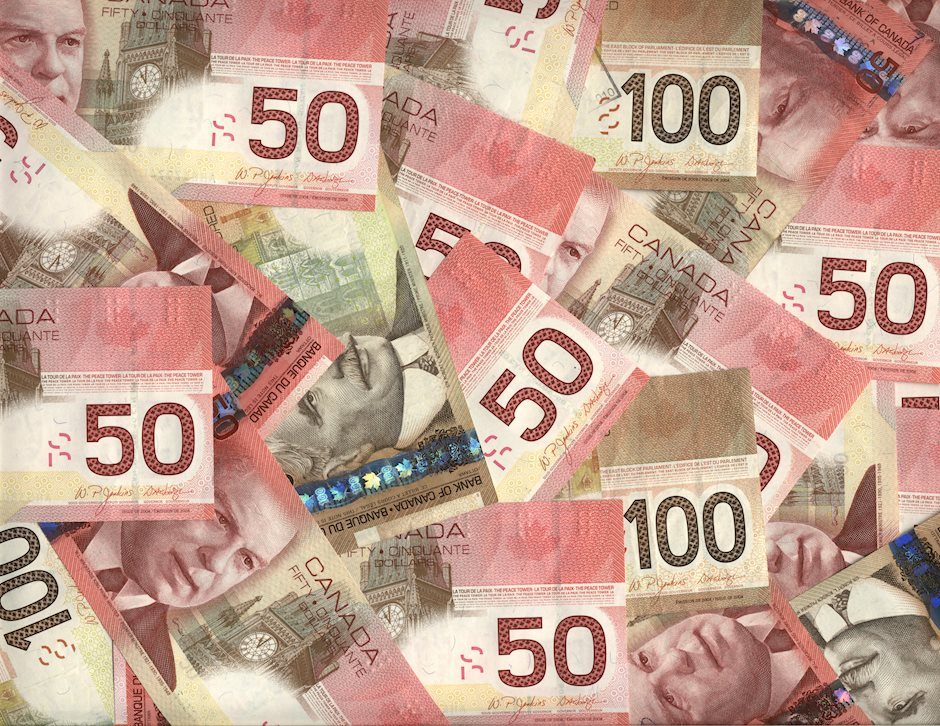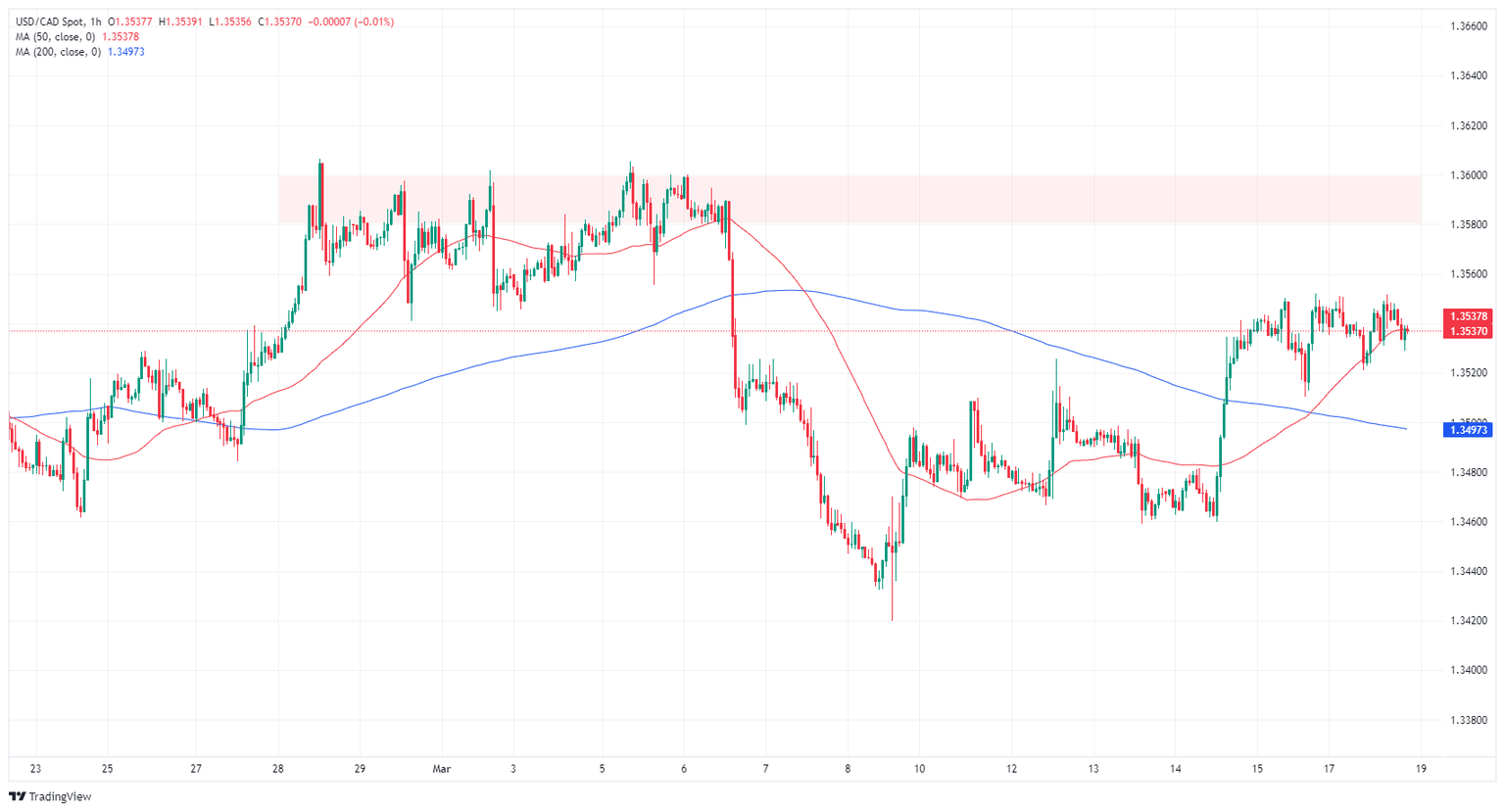Canadian Dollar rotates into the middle on quiet Monday ahead of central-bank-laden week
- Canadian Dollar finds little chart momentum as investors gear up for a busy week.
- Canadian CPI inflation first on the docket, expected to tick up on Tuesday.
- Fed Wednesday brings rate call, updated Dot Plot.

The Canadian Dollar (CAD) is sifting chart paper on Monday, easing into the trading week as investors take a moment to breathe before a full-pull central bank week begins in earnest. The Federal Reserve (Fed) is expected to update its summary of interest rate forecasts, or Dot Plot, on Wednesday. American Purchasing Managers Index (PMI) figures are also due later in the week on Thursday.
Canada is up first this week, with an update to Consumer Price Index (CPI) inflation in February. The Bank of Canada (BoC) will update its Summary of Deliberations on Wednesday, cast in the shadow of the Federal Open Market Committee’s (FOMC) mid-week Press Conference.
Daily digest market movers: Canadian Dollar churns in place as investors await the spark
- The Canadian Raw Material Price Index and Industrial Product Prices for February printed to little effect.
- Canadian Raw Materials prices rose 2.1% in February, a five-month high and a sharp increase from the previous 1.2%.
- Industrial Product Prices rose in February, printing at 0.7% versus the previous month’s -0.1%, the measure’s highest increase in six months.
- Canada’s CPI inflation for February is expected to tick higher on Tuesday, forecast to print at 3.1% YoY versus the previous 2.9%.
- MoM Canadian CPI inflation is expected to bounce to 0.6% from 0.0%.
- The BoC’s Core CPI inflation printed at 2.4% in January, the indicator’s lowest print since May of 2021.
- Wednesday is another FOMC day. Updates to the Fed’s Dot Plot are expected, as well as a Press Conference by Fed Chairman Jerome Powell.
- According to the CME’s FedWatch Tool, rate markets are pricing in nearly equal odds of no rate cut at the Fed’s June rate call, down significantly from 70% odds of a June rate cut at this time last week.
Canadian Dollar price today
The table below shows the percentage change of Canadian Dollar (CAD) against listed major currencies today. Canadian Dollar was the weakest against the Australian Dollar.
| USD | EUR | GBP | CAD | AUD | JPY | NZD | CHF | |
| USD | 0.04% | 0.05% | -0.01% | -0.02% | 0.15% | 0.06% | 0.35% | |
| EUR | -0.05% | 0.01% | -0.05% | -0.03% | 0.12% | 0.03% | 0.28% | |
| GBP | -0.05% | 0.00% | -0.05% | -0.03% | 0.12% | 0.03% | 0.29% | |
| CAD | 0.01% | 0.05% | 0.05% | -0.02% | 0.15% | 0.07% | 0.33% | |
| AUD | 0.02% | 0.07% | 0.07% | 0.00% | 0.17% | 0.08% | 0.35% | |
| JPY | -0.16% | -0.12% | -0.05% | -0.16% | -0.17% | -0.08% | 0.18% | |
| NZD | -0.06% | -0.03% | -0.03% | -0.06% | -0.06% | 0.09% | 0.27% | |
| CHF | -0.33% | -0.30% | -0.30% | -0.35% | -0.32% | -0.17% | -0.27% |
The heat map shows percentage changes of major currencies against each other. The base currency is picked from the left column, while the quote currency is picked from the top row. For example, if you pick the Euro from the left column and move along the horizontal line to the Japanese Yen, the percentage change displayed in the box will represent EUR (base)/JPY (quote).
Technical analysis: Canadian Dollar spins in place on Monday, USD/CAD continues to churn just below 1.3550
The Canadian Dollar (CAD) is broadly flat against most of its major currency peers on Monday as markets ease into the new trading week. The CAD is next to flat against the US Dollar (USD), the Euro (EUR), the Pound Sterling (GBP), the Australian Dollar (AUD) and the New Zealand Dollar (NZD) on Monday. Despite flat markets, the Canadian Dollar is up around a third of a percent against the Swiss Franc (CHF) on the day.
USD/CAD is cycling tightly within familiar technical levels, playing just below 1.3550. Intraday technical support sits at the 1.3500 handle, parked at the 200-hour Simple Moving Average (SMA). A near-term supply zone is priced in between 1.3600 and 1.3580 to cut off any bullish breakouts.
USD/CAD hourly chart

Canadian Dollar FAQs
The key factors driving the Canadian Dollar (CAD) are the level of interest rates set by the Bank of Canada (BoC), the price of Oil, Canada’s largest export, the health of its economy, inflation and the Trade Balance, which is the difference between the value of Canada’s exports versus its imports. Other factors include market sentiment – whether investors are taking on more risky assets (risk-on) or seeking safe-havens (risk-off) – with risk-on being CAD-positive. As its largest trading partner, the health of the US economy is also a key factor influencing the Canadian Dollar.
The Bank of Canada (BoC) has a significant influence on the Canadian Dollar by setting the level of interest rates that banks can lend to one another. This influences the level of interest rates for everyone. The main goal of the BoC is to maintain inflation at 1-3% by adjusting interest rates up or down. Relatively higher interest rates tend to be positive for the CAD. The Bank of Canada can also use quantitative easing and tightening to influence credit conditions, with the former CAD-negative and the latter CAD-positive.
The price of Oil is a key factor impacting the value of the Canadian Dollar. Petroleum is Canada’s biggest export, so Oil price tends to have an immediate impact on the CAD value. Generally, if Oil price rises CAD also goes up, as aggregate demand for the currency increases. The opposite is the case if the price of Oil falls. Higher Oil prices also tend to result in a greater likelihood of a positive Trade Balance, which is also supportive of the CAD.
While inflation had always traditionally been thought of as a negative factor for a currency since it lowers the value of money, the opposite has actually been the case in modern times with the relaxation of cross-border capital controls. Higher inflation tends to lead central banks to put up interest rates which attracts more capital inflows from global investors seeking a lucrative place to keep their money. This increases demand for the local currency, which in Canada’s case is the Canadian Dollar.
Macroeconomic data releases gauge the health of the economy and can have an impact on the Canadian Dollar. Indicators such as GDP, Manufacturing and Services PMIs, employment, and consumer sentiment surveys can all influence the direction of the CAD. A strong economy is good for the Canadian Dollar. Not only does it attract more foreign investment but it may encourage the Bank of Canada to put up interest rates, leading to a stronger currency. If economic data is weak, however, the CAD is likely to fall.
Author

Joshua Gibson
FXStreet
Joshua joins the FXStreet team as an Economics and Finance double major from Vancouver Island University with twelve years' experience as an independent trader focusing on technical analysis.

















